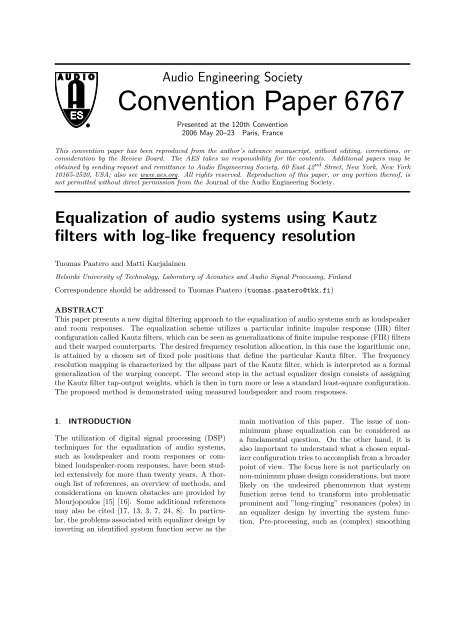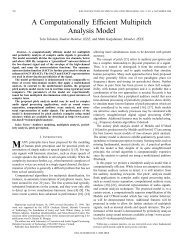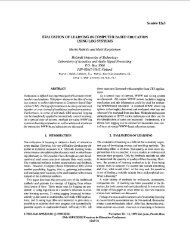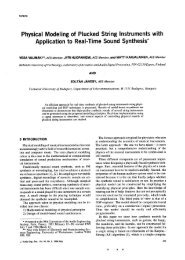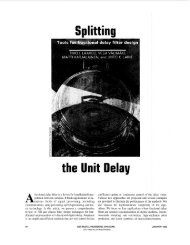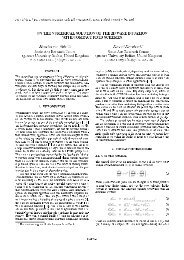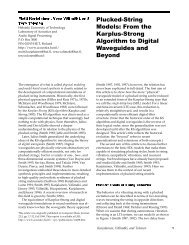Equalization of Audio Systems using Kautz Filters ... - TKK Acoustics
Equalization of Audio Systems using Kautz Filters ... - TKK Acoustics
Equalization of Audio Systems using Kautz Filters ... - TKK Acoustics
Create successful ePaper yourself
Turn your PDF publications into a flip-book with our unique Google optimized e-Paper software.
<strong>Audio</strong> Engineering SocietyConvention Paper 6767Presented at the 120th Convention2006 May 20–23 Paris, FranceThis convention paper has been reproduced from the author’s advance manuscript, without editing, corrections, orconsideration by the Review Board. The AES takes no responsibility for the contents. Additional papers may beobtained by sending request and remittance to <strong>Audio</strong> Engineering Society, 60 East 42 nd Street, New York, New York10165-2520, USA; also see www.aes.org. All rights reserved. Reproduction <strong>of</strong> this paper, or any portion there<strong>of</strong>, isnot permitted without direct permission from the Journal <strong>of</strong> the <strong>Audio</strong> Engineering Society.<strong>Equalization</strong> <strong>of</strong> audio systems <strong>using</strong> <strong>Kautz</strong>filters with log-like frequency resolutionTuomas Paatero and Matti KarjalainenHelsinki University <strong>of</strong> Technology, Laboratory <strong>of</strong> <strong>Acoustics</strong> and <strong>Audio</strong> Signal Processing, FinlandCorrespondence should be addressed to Tuomas Paatero (tuomas.paatero@tkk.fi)ABSTRACTThis paper presents a new digital filtering approach to the equalization <strong>of</strong> audio systems such as loudspeakerand room responses. The equalization scheme utilizes a particular infinite impulse response (IIR) filterconfiguration called <strong>Kautz</strong> filters, which can be seen as generalizations <strong>of</strong> finite impulse response (FIR) filtersand their warped counterparts. The desired frequency resolution allocation, in this case the logarithmic one,is attained by a chosen set <strong>of</strong> fixed pole positions that define the particular <strong>Kautz</strong> filter. The frequencyresolution mapping is characterized by the allpass part <strong>of</strong> the <strong>Kautz</strong> filter, which is interpreted as a formalgeneralization <strong>of</strong> the warping concept. The second step in the actual equalizer design consists <strong>of</strong> assigningthe <strong>Kautz</strong> filter tap-output weights, which is then in turn more or less a standard least-square configuration.The proposed method is demonstrated <strong>using</strong> measured loudspeaker and room responses.1. INTRODUCTIONThe utilization <strong>of</strong> digital signal processing (DSP)techniques for the equalization <strong>of</strong> audio systems,such as loudspeaker and room responses or combinedloudspeaker-room responses, have been studiedextensively for more than twenty years. A thoroughlist <strong>of</strong> references, an overview <strong>of</strong> methods, andconsiderations on known obstacles are provided byMourjopoulos [15] [16]. Some additional referencesmay also be cited [17, 13, 3, 7, 24, 8]. In particular,the problems associated with equalizer design byinverting an identified system function serve as themain motivation <strong>of</strong> this paper. The issue <strong>of</strong> nonminimumphase equalization can be considered asa fundamental question. On the other hand, it isalso important to understand what a chosen equalizerconfiguration tries to accomplish from a broaderpoint <strong>of</strong> view. The focus here is not particularly onnon-minimum phase design considerations, but morelikely on the undesired phenomenon that systemfunction zeros tend to transform into problematicprominent and ”long-ringing” resonances (poles) inan equalizer design by inverting the system function.Pre-processing, such as (complex) smoothing
PAATERO AND KARJALAINEN<strong>Equalization</strong> <strong>using</strong> <strong>Kautz</strong> filters on log-scaleproduce orthonormal tap-output impulse responses.However, a <strong>Kautz</strong> filter is in fact more genuinelya generalization <strong>of</strong> the FIR filter and its warpedcounterparts, which will be demonstrated in terms<strong>of</strong> properties <strong>of</strong> the allpass filter that constitute thebackbone <strong>of</strong> the tapped transversal structure <strong>of</strong> Figure1.The time-domain counterpart <strong>of</strong> (1), the <strong>Kautz</strong> filterimpulse response, is given byĥ(n) =N∑w i g i (n), (2)i=0where functions {g i (n)} N i=0 are impulse responses orinverse z-transforms <strong>of</strong> functions {G i (z)} N i=0 . Themeaning <strong>of</strong> orthonormality is specified most economicallyby defining the time-domain inner product <strong>of</strong>two (causal) signals x(n) and y(n),(x, y) :=∞∑x(n)y ∗ (n). (3)n=0Now, impulse responses {g i (n)} N i=0 are orthogonal inthe sense that (g i , g k ) = 0 for i ≠ k, and normal,since (g i , g i ) = 1 for i = 0, . . . , N.A reasonable presumption in modeling a real responseis that the poles should be real or occurin complex conjugate pairs. For complex conjugatepoles, an equivalent real <strong>Kautz</strong> filter formulation [1],depicted in Fig. 2, prevents dealing with complex(internal) signals and filter weights. The allpasscharacteristics <strong>of</strong> the transversal blocks is restoredby shifting the denominators in Fig. 2 one step tothe right and by compensating for the change in thetap-output blocks. A mixture <strong>of</strong> structures in Fig. 1and Fig. 2 is used in the case <strong>of</strong> both real and complexconjugate poles.3. MODELING AND EQUALIZATION USINGKAUTZ FILTERSOur previous proposals for utilizing <strong>Kautz</strong> filters inrelation to audio and acoustic systems have beenbased on approximative modeling <strong>of</strong> given (measured<strong>of</strong> somehow identified) target responses. Thedesign procedure is then particularly straightforward:a desired pole set is generated with respectFig. 2: One possible realization <strong>of</strong> a real <strong>Kautz</strong>filter, corresponding to a sequence <strong>of</strong> complexconjugatepole pairs [1]. The normalization termsare p i = √ √(1 − ρ i )(1 + ρ i − γ i )/2 and q i =(1 − ρi )(1 + ρ i + γ i )/2, where γ i = −2RE{z i }and ρ i = |z i | 2 are expanded polynomial coefficients<strong>of</strong> the second-order blocks.to the target response h(n) and the approximation(or the model) is composed asĥ(n) =N∑c i g i (n), c i = (h, g i ). (4)i=0That is, the filter weights are the orthogonal expansioncoefficients (<strong>Kautz</strong>-Fourier coefficients) <strong>of</strong> h(n)with respect to the choice <strong>of</strong> basis functions. One <strong>of</strong>the favorable specialities <strong>of</strong> <strong>Kautz</strong> filter design comparedto other IIR or pole-zero filter configurationsis that the approximation is independent <strong>of</strong> rearrangement<strong>of</strong> the pole set, which implies means forreducing as well as extending the model by pruning,tuning, and appending poles, respectively. In addition,the use <strong>of</strong> orthogonal expansion coefficientscorrespond to least-square (LS) design with respectto the particular pole set, and as a consequence <strong>of</strong>the orthogonality, the approximation error (energy)is given simply asE = (h, h) −N∑c 2 i , (5)i=0where (h, h) is the energy <strong>of</strong> the target response.As an alternative to the evaluation <strong>of</strong> c i = (h, g i )<strong>using</strong> the inner product formula (3), the <strong>Kautz</strong> filtertap-output weights are also attained by feeding thesignal h(−n) to the <strong>Kautz</strong> filter and reading the tapoutputs x i (n) = G i [h(−n)] at n = 0: c i = x i (0).That is, all inner products in (4) are implementedAES 120 th Convention, Paris, France, 2006 May 20–23Page 3 <strong>of</strong> 12
PAATERO AND KARJALAINEN<strong>Equalization</strong> <strong>using</strong> <strong>Kautz</strong> filters on log-scalesimultaneously <strong>using</strong> filtering. In the case <strong>of</strong> an FIRfilter this would equal design by truncation <strong>of</strong> h(n).3.1. Least-square equalization <strong>using</strong> <strong>Kautz</strong> filtersAs for any pole-zero model configuration, it is notin general a straightforward operation to invert or“flip” a <strong>Kautz</strong> model <strong>of</strong> a system into its inversesystem or equalizing counterpart. In fact, this kind<strong>of</strong> direct inversion schemes are particularly unattractivefrom the point <strong>of</strong> view <strong>of</strong> <strong>Kautz</strong> filters because<strong>of</strong> the numerator configuration in the transfer function.The art <strong>of</strong> equalization by direct inversiontechniques [17, 14, 3, 15] will not be considered further,but it is nevertheless interesting to notice thatmany <strong>of</strong> the consequential requirements posed uponan equalizer are inherently available in a <strong>Kautz</strong> filterconfiguration, namely,• genuine IIR nature <strong>of</strong> the equalizer• explicit control over the poles• pure delays and allpass filters as building blocks• linear in the weight-parameters, allowing a wellposedLS configurationThe equalization configuration that is more interestingfrom the <strong>Kautz</strong> filter point <strong>of</strong> view can becharacterized as direct equalization: the equalizer(with impulse response h eq (n)) is identified in cascadewith the system h(n) to be equalized, to meetor approximate the ideal equalization targetĥ(n) = h(n) ∗ h eq (n) ≈ δ(n − ∆), (6)where δ(·) is the unit impulse, including a potentialdelay ∆. Also in this direct configuration it isstill possible to use an inverted target response asthe basis <strong>of</strong> design, directly as in (4) or for exampleto identify just the poles. These alternatives willbe demonstrated in the loudspeaker equalization example.It is noteworthy that some <strong>of</strong> the knownproblems associated to <strong>using</strong> an inverted response toconstruct the equalizer, such as “ringing poles” andtruncation effects, do not (necessarily) pass on to the<strong>Kautz</strong> equalizer. This may by itself reduce the needfor complicated pre-processing operations. In addition,even this simple approximation setup is by nomeans constrained to minimum-phase or magnitudeonlyequalization: the target response may obviouslybe constructed to take into account phase as well asmagnitude equalization.A more genuine form <strong>of</strong> direct equalization is providedby the least-square configuration [14]: thesquare error in the approximation (6) is minimizedwith respect to the equalizer parameters (filter coefficients).In terms <strong>of</strong> the <strong>Kautz</strong> equalizer, the tapoutputweights {w i } are optimized according to( )∑min (ĥ(n) − δ(n −w ∆))2 , (7)inwhere the equalizer responseĥ(n) =N∑w i x i (n), x i (n) = g i (n) ∗ h(n), (8)i=0is the <strong>Kautz</strong> filter response to the input h(n). Usingsystem identification terminology, the equalizationsetup is an output-error configuration with respectto a special choice <strong>of</strong> model structure. It can evenbe considered as a generalized linear prediction formulation.Furthermore, it is a quadratic LS problemwith a well-defined and unique solution thatis obtained from the corresponding normal equations:if the <strong>Kautz</strong> equalizer tap-output responsesx i (n) = g i (n) ∗ h(n) are assembled into a “generalizedchannel convolution matrix”⎛⎞x 0 (0) · · · x N (0)x 0 (1) · · · x N (1)S = ⎜⎝.. .. .⎟⎠ , (9)x 0 (L) · · · x N (L)then the normal equations submit to the matrix formS T Sw = s, w = [w 0 · · · w N ] T , (10)where s is the (cross-)correlation vector between thetap-output responses and the desired response d(n),s i = (d, x i ). The matrix product S T S, where (·) Tdenotes transpose <strong>of</strong> a matrix, implements correlationanalysis <strong>of</strong> the tap-output responses, (x i , x j ), interm <strong>of</strong> the inner product (3), where it is presumedthat the <strong>Kautz</strong> filter responses are real-valued. Inthe case <strong>of</strong> an impulse as the desired response,d(n) = δ(n − ∆), the correlation vector simply picksthe (∆ + 1)th row <strong>of</strong> the matrix S,s = [x 0 (∆) · · · x N (∆)] T . (11)AES 120 th Convention, Paris, France, 2006 May 20–23Page 4 <strong>of</strong> 12
PAATERO AND KARJALAINEN<strong>Equalization</strong> <strong>using</strong> <strong>Kautz</strong> filters on log-scale20a) poles16b) allpass block phasesMagnitude / dB100−10−20−30Imaginary part0.50−0.5−1−1 −0.5 0 0.5 1Real partc) tap phases and pole freqs.phase / rad4200 1 2 3angle / radd) ap phase der vs. mag resp−4010 −1 10 0Frequency / Hzphase / rad60402010.5Fig. 3: Magnitude responses <strong>of</strong> the <strong>Kautz</strong> filter tapoutputimpulse responses with respect to the proposedlogarithmic distribution <strong>of</strong> poles.00 1 2 3angle / rad01 2 3angle / radbetween the allpass operator and the correspondingorthonormal filter structure (the <strong>Kautz</strong> filter) is explainedmore thoroughly in [21]. The negated phasefunction <strong>of</strong> the allpass filter (solid line in Fig. 4(c))can be interpreted as the frequency scale mapping,whereas its derivative in Fig. 4(d) characterizes thefrequency resolution allocation introduced by thechoice <strong>of</strong> poles. The upper curve in Fig. 4(d) is thesum <strong>of</strong> magnitude responses <strong>of</strong> Fig. 3, which showsquite explicitly that the chosen resolution descriptionis somehow meaningful.The effect <strong>of</strong> pole radius tuning is demonstrated inFig. 5 <strong>using</strong> various displaying scales for the allpassphase mappings and corresponding derivatives. It isnoteworthy that the phase responses are quite insensitiveto relatively big changes in the radius pr<strong>of</strong>ile.The pole distributions are chosen purposefully closeto the unit circle to produce spiking in the resolutionmapping: there is a clear transition from a localizedresolution to a smoother overall description whenthe radius parameter R in Eq. (16) is reduced. Anothernotable aspect is that the smoothness scaleswell (evenly for the whole frequency range) with thechosen rule for the pole radius mapping.4. EXAMPLES OF LS EQUALIZATION USINGKAUTZ FILTERSIn this section we apply the proposed principles<strong>of</strong> <strong>Kautz</strong> filter design for the equalization <strong>of</strong> loudspeakerand room responses. The examination <strong>of</strong>Fig. 4: a) The poles set, b) negated phase functions<strong>of</strong> 2nd order allpass blocks, c) (allpass) tapoutputphases – overall phase (solid line) is the frequencyscale mapping (circles indicate pole positionson this mapping), and d) phase derivative (lowercurve) w.r.t. sum <strong>of</strong> <strong>Kautz</strong> filter tap-output magnituderesponses (scaled).many practical issues would need a more thoroughinvestigation; here we take only some cases that illustratethe characteristics and capabilities <strong>of</strong> <strong>Kautz</strong>equalizers.4.1. Loudspeaker equalization, Case 1In this first example <strong>of</strong> <strong>Kautz</strong> filter equalization, aninverted minimum-phase target response (with respectto a measured loudspeaker response) is usedboth directly and indirectly to construct the equalizer.The <strong>Kautz</strong> filter poles are generated in bothcases <strong>using</strong> a warped counterpart <strong>of</strong> the BU-method[20] with respect to the inverted target response.The equalizer filter order is chosen to be 38 (18 complexconjugate pole pairs and two real poles). Thepurpose <strong>of</strong> this example is to demonstrate that twovery different equalizer parametrization schemes,corresponding to Equations (4) and (8), respectively,produce very similar magnitude response equalizationresults, as depicted in Fig. 6.The early part <strong>of</strong> the measured loudspeaker impulseresponse and the LS equalized response are displayedAES 120 th Convention, Paris, France, 2006 May 20–23Page 6 <strong>of</strong> 12
PAATERO AND KARJALAINEN<strong>Equalization</strong> <strong>using</strong> <strong>Kautz</strong> filters on log-scale1a) pole distributionsb) allpass phases30Imaginary part0.50−0.5−1−1 −0.5 0 0.5 1Real partc) w.r.t. log−scalephase /rad604020phasederivative00 1 2 3angle / radd) log− and dB−scaleMagnitude / dB20100−10phase /rad604020010 0angle / rad (log)phase /rad (db)30201010 0angle / rad (log)−20−30−4010 2 10 3 10 4Frequency / HzFig. 5: Allpass filter characteristics for varying poleradius damping, a) pole sets, b) phase functions andphase derivatives, c) on log-scale, and d) in dBs onlog-scale.Fig. 6: Magnitude responses from bottom totop: measured loudspeaker response, LS equalized(method (8)), pole frequencies, equalized <strong>using</strong> (4)w.r.t. inverted target, corresponding equalizer responses.in panels (a) and (b) <strong>of</strong> Fig. 7. In Fig. 7(c) the LSequalizer is designed with respect to a delay ∆ = 12in the target <strong>of</strong> equalization. The pole set that isgenerated from a minimum phase target responseis not very good at producing pure delay components,which results also in inefficiency in magnitudeequalization (not shown). A somewhat trivial wayto attain better equalization is to include zeros inthe <strong>Kautz</strong> filter pole set: in Fig. 7(d) the equalizeris equipped with 12 additional poles at the origin,that is, part <strong>of</strong> the <strong>Kautz</strong> filter is implemented as anFIR filter substructure.4.2. Loudspeaker equalization, Case 2Another example <strong>of</strong> <strong>Kautz</strong> equalizer design is presentedin Fig. 8. It depicts the same loudspeakerresponse as in Case 1 having a relatively non-flatmagnitude response (curve (a)). The response iscorrected by a 24 th order (12 pole pairs) <strong>Kautz</strong> filterwith logaritmically positioned pole frequenciesbetween 80 Hz and 23 kHz (indicated by verticallines in the middle <strong>of</strong> the figure) and R = 0.03(see Eq. 16). After low- and high-frequency roll<strong>of</strong>fcompensations to avoid boosting <strong>of</strong>f-bands <strong>of</strong> thespeaker, as shown by curve (c), the equalizer filterresulting from <strong>Kautz</strong> LS equalization shows its mag-nitude response in curve (d). The equalized responseis plotted in curve (e) and as a 1/3-octave smoothedversion in curve (f).Filter orders from 8 up (4 pole pairs) give useful resultsin this case, although the selection <strong>of</strong> order andpole positions may introduce considerable variationin flatness <strong>of</strong> the result. Therefore full optimizationrequires a search over sets <strong>of</strong> poles and filter orders,in spite <strong>of</strong> the fact that the LS procedure itself alwaysgives optimal tap coefficients for a given fixedorder and pole set.Curve (g) in Fig. 8 demonstrates the effect <strong>of</strong> <strong>Kautz</strong>pole radii selection. In this case the poles are settoo close to the unit circle (R = 0.8), thus the frequencyranges around pole frequencies get too muchemphasis. Otherwise, in most cases, the selection <strong>of</strong>pole radii is not critical at all. Even very small radii,such as R = 10 −5 , work well in this case.Comparison <strong>of</strong> curves (e) and (g) explains alsoclearly why LS equalization <strong>using</strong> the <strong>Kautz</strong> filterconfiguration behaves favorably with zeros in the responseto be equalized, while exact inversion <strong>of</strong> a responsewith deep dips results in undesirable peaksand long-ringing decay times in the equalizer [4]. InAES 120 th Convention, Paris, France, 2006 May 20–23Page 7 <strong>of</strong> 12
PAATERO AND KARJALAINEN<strong>Equalization</strong> <strong>using</strong> <strong>Kautz</strong> filters on log-scale1a) loudspeaker response1b) EQ: poles from inv. target700.50.560(g)0050(f)−0.50 50 10010.5c) delay in EQ target−0.50 50 10010.5d) delay and zeroslevel [dB]4030(e)(d)0020(c)−0.50 50 100−0.50 50 100Fig. 7: Early part <strong>of</strong> time-domain responses: a) measuredloudspeaker, b) LS equalized (<strong>Kautz</strong> filter order38), c) <strong>using</strong> the same set <strong>of</strong> poles and includingdelay (∆ = 12) in target, and d) by including 12poles at the origin and delay (∆ = 12) in target.<strong>Kautz</strong> filters the pole radii determine the maximumQ values <strong>of</strong> resonances. If the pole radii are selectedconservatively, no excess peaking and ringing <strong>of</strong> resonancesappear in the equalizer response.4.3. Loudspeaker equalization, Case 3In this subsection we demonstrate further the use <strong>of</strong><strong>Kautz</strong> modeling in loudspeaker equalization includingboth magnitude and phase correction. Whilein previous studies with warped and <strong>Kautz</strong> filters[7, 5, 21] we have applied magnitude-only equalization,it is interesting to investigate the ability <strong>of</strong><strong>Kautz</strong> inverse models to correct also the phase behavior.For clarity <strong>of</strong> phase curves, it is preferable to demonstratethe phase correction by <strong>using</strong> a synthetic (simulated)loudspeaker response instead <strong>of</strong> a real measuredone. Figures 9 and 10 depict the magnitudeand group delay behaviors <strong>of</strong> an idealized two-wayloudspeaker. It consists <strong>of</strong> a low-frequency driver ina wented box (4 th order highpass at 80 Hz) and ahigh-frequency driver (up to 18 kHz), both with flatresponse between roll-<strong>of</strong>f frequencies. They are combinedwith a second order Linkwitz-Riley crossover100(b)(a)10 2 10 3 10 4Frequency [Hz]Fig. 8: Basic example <strong>of</strong> loudspeaker response equalizationby <strong>Kautz</strong> filter inverse modeling. From bottomup: (a) measured magnitude response, (b) sameone 1/3-octave smoothed, (c) low and high roll-<strong>of</strong>fcompensation, (d) magnitude response <strong>of</strong> 24 th order(12 pole pairs) <strong>Kautz</strong> equalizer, (e) equalized magnituderesponse, (f) same one 1/3-octave smoothed,and (g) <strong>Kautz</strong> equalized response with R = 0.03.Vertical lines at 35 dB level indicate the frequencypositions corresponding to logarithmically spacedpole angles.network [10, 11], which in an ideal case results in aflat magnitude response at the main axis.In this particular case we investigate a loudspeakerwhere the acoustic center <strong>of</strong> the high-frequencydriver is 17 cm behind the acoustic center <strong>of</strong> thelow-frequency unit. This means a temporal nonalignment<strong>of</strong> about 0.5 ms, which results in ripple<strong>of</strong> the main axis magnitude response (‘Original’ inFig. 9) and similarly a non-flat group delay response(‘Original’ in Fig. 10). The magnitude response error<strong>of</strong> this amount is easily audible. Although thegroup delay deviation remains within 1 ms above 300Hz, which is hardly noticeable in practice, it is interestingto check how the phase correction by <strong>Kautz</strong>AES 120 th Convention, Paris, France, 2006 May 20–23Page 8 <strong>of</strong> 12
PAATERO AND KARJALAINEN<strong>Equalization</strong> <strong>using</strong> <strong>Kautz</strong> filters on log-scale153Level / dB1050-5EQ excess-phaseEQ min-phaseOriginalGroup delay / ms2.521.510.5EQ excess-phase-10-15HP LP10 2 10 3 10 4Frequency / Hz0- - - EQ min-phase ––– Original-0.510 2 10 3 10 4Frequency / HzFig. 9: Magnitude responses <strong>of</strong> the simulated loudspeaker:LP = low-pass crossover; HP = highpasscrossover; original = response due to driverdistance misalignment; minimum-phase equalized;excess-phase equalized response.LS equalization works. This brings necessarily increasedlatency beyond the maximum group delay<strong>of</strong> the original response.Curves ‘EQ min-phase’ in Figs. 9 and 10 show themagnitude and group delay responses <strong>of</strong> the simulatedloudspeaker when a <strong>Kautz</strong> equalizer is designedbased on the minimum-phase part <strong>of</strong> the loudspeakerimpulse response. A <strong>Kautz</strong> filter <strong>of</strong> 18 pole pairs wasdesigned with logarithmic distribution <strong>of</strong> poles between80 Hz and 23 kHz and pole radius coefficientR = 0.1. High- and low-frequency roll-<strong>of</strong>fs are compensatedin EQ design to remain as they were originally.After equalization the magnitude response isflat within ±1 dB, while the group delay (dashedline) is not essentially improved.Curves ‘EQ excess-phase’ in Figs. 9 and 10 illustratethe results <strong>of</strong> magnitude plus phase equalizationwith a <strong>Kautz</strong> LS equalizer. In this case thetarget response <strong>of</strong> the equalized system is given asa delayed impulse, with a latency higher than themaximum delay <strong>of</strong> the loudspeaker itself. The targetgroup delay was set here to 1.5 ms (66 samplesat 44.1 kHz sample rate). A <strong>Kautz</strong> equalizer was designedwith 8 logarithmically distributed pole pairswithin 80 Hz to 23 kHz, with R = 0.05, plus 96 polesat the origin. Notice that the latter ones correspondagain to FIR filter behavior, so that the equalizer isa mixture <strong>of</strong> an FIR and an IIR filter.Fig. 10: Group delay responses <strong>of</strong> the simulatedloudspeaker: original = ripple due to driver distancemisalignment; minimum-phase equalized; excessphaseequalized response with extra group delay.After applying excess-phase equalization the magnituderesponse in Fig. 9 is again within ±1 dB, whilethe group delay curve in Fig. 10 has ripple less than±0.1 ms. (The growth <strong>of</strong> low-frequency group delaycomes from the high-pass behavior <strong>of</strong> the loudspeaker,which is not compensated for.)4.4. Room response equalization, Case 4In this subsection we examine a basic example <strong>of</strong>loudspeaker plus room response correction <strong>using</strong><strong>Kautz</strong> LS equalization. The loudspeaker used hada lower roll-<strong>of</strong>f frequency <strong>of</strong> about 80 Hz, compensatedin target response design. The room was alistening room <strong>of</strong> 33 m 2 with fairly well controlledacoustics. Figure 11 shows the first 5 ms <strong>of</strong> the measuredimpulse response in pane (a) and magnituderesponse in pane (c) in full resolution and 1/3-octavesmoothed.A <strong>Kautz</strong> equalizer <strong>of</strong> order 24 (12 pole pairs) wasdesigned with logarithmically positioned pole frequenciesbetween 50 Hz and 20 kHz, <strong>using</strong> the poleradius parameter value R = 0.5. The resulting impulseresponse and magnitude response are plottedin Fig. 11, panes (b) and (d). The magnitude responseis flattened as desired. In the impulse responsesome low-frequency oscillation is damped,but the peaks corresponding to reflections from surfacescannot <strong>of</strong> course be canceled out by such a loworderequalizer. However, even equalizer orders <strong>of</strong>AES 120 th Convention, Paris, France, 2006 May 20–23Page 9 <strong>of</strong> 12
PAATERO AND KARJALAINEN<strong>Equalization</strong> <strong>using</strong> <strong>Kautz</strong> filters on log-scale0.5(a)0.5(b)Amplitude0Amplitude0-0.5-0.50 1 2 3 4 5Time [ms]0 1 2 3 4 5Time [ms]level [dB]20100-10-20level [dB]20100-10-2010 2 10 3 10 4Frequency [Hz]10 2 10 3 10 4Frequency [Hz]Fig. 11: <strong>Kautz</strong> equalization <strong>of</strong> a room response: (a) first 5 ms <strong>of</strong> the impulse response, (b) first 5 ms <strong>of</strong> theequalized impulse response, (c) original magnitude response, and (d) <strong>Kautz</strong> equalized magnitude response.In magnitude responses the lifted upper curves are computed through 1/3-octave smoothing.8–12 (4–6 pole pairs) seen to provide useable equalizationresults in this particular case.In principle the <strong>Kautz</strong> equalization is capable to approachperfect inversion or any resolution <strong>of</strong> magnitudeand phase equalization. In practice there arehowever limitations, such as ability to do major correctionsin phase behavior, e.g., proper temporal envelopemanipulation as done in [4]. This remains atopic for future research.5. DISCUSSION AND CONCLUSIONSMany DSP techniques have been proposed earlierfor the equalization <strong>of</strong> audio reproduction channels,either for loudspeaker only or for combined loudspeakerand room responses. We have earlier investigateddifferent frequency warping techniques,including <strong>Kautz</strong> filters, which allow for maximumflexibility <strong>of</strong> frequency resolution control in equalizerdesign [21]. The previous <strong>Kautz</strong> filter equalizerswere designed as models for responses that wereseparately inverted for given reproduction system responses.For simplicity, the inversion was done onlyfor the minimum-phase part.In the present study we have extended the use <strong>of</strong><strong>Kautz</strong> filter equalizers to more general cases by systematicdesign <strong>of</strong> inverse filter models directly fromgiven impulse responses <strong>of</strong> audio reproduction systems.The novelty is to apply least square optimaldesign <strong>of</strong> <strong>Kautz</strong> filter tap coefficients for a fixed set<strong>of</strong> system poles. Logarithmic frequency resolution isapproximated by setting the pole angle distributionlogarithmically and by controlling the pole radii toapproximate constant-Q behavior. This is conceptuallysimilar to inverse (FIR) filter design throughlinear prediction for uniform frequency resolution.An advantage <strong>of</strong> the new method is that it canAES 120 th Convention, Paris, France, 2006 May 20–23Page 10 <strong>of</strong> 12
PAATERO AND KARJALAINEN<strong>Equalization</strong> <strong>using</strong> <strong>Kautz</strong> filters on log-scalebe applied to non-minimum phase EQ design, asdemonstrated for loudspeaker equalization. Anotherfavorable feature is the inherent control <strong>of</strong> sharpmagnitude response dips to avoid sharp peaks andlong-ringing temporal decays in the equalizer design.This is done simply by limiting the Q-values <strong>of</strong> the<strong>Kautz</strong> system pole pairs.After introducing <strong>Kautz</strong> filters in Section 2 and thenew principle <strong>of</strong> <strong>Kautz</strong> equalization in Section 3, aset <strong>of</strong> case studies are presented in Section 4. Theseinclude different loudspeaker response corrections,including non-minimum phase equalization. A typicallistening room case is also studied for combinedloudspeaker and room response equalization. Thisis primarily magnitude-only equalization; more detailedcontrol <strong>of</strong> phase behavior is left to future research.Low-order <strong>Kautz</strong> equalizers (4 to 12 pole pairs) arefound in practice to yield good magnitude responsecorrection. Phase correction may need higher orderswith a set <strong>of</strong> system poles at the origin and excessdelay required for the target response.<strong>Kautz</strong> filters are know to be numerically robust dueto the allpass type <strong>of</strong> elements used in the implementation.For low orders it is possible to map thetransfer function to direct form IIR structures formaximal efficiency on DSP processors. This andmany other practical questions remain however out<strong>of</strong> the scope <strong>of</strong> this paper, which is the first stepin introducing this new concept <strong>of</strong> audio equalizerdesign.6. ACKNOWLEDGMENTThe work <strong>of</strong> Tuomas Paatero has been funded by theAcademy <strong>of</strong> Finland, project No. 205787 (Virtual<strong>Acoustics</strong> and <strong>Audio</strong> 2015).7. REFERENCES[1] P. W. Broome, “Discrete Orthonormal Sequences”,Journal <strong>of</strong> the Association for ComputingMachinery, vol. 12, no. 2, pp. 151–168,1965.[2] J. C. Brown, “Calculation <strong>of</strong> a constant Q spectraltransform”, Journal <strong>of</strong> the Acoustical Society<strong>of</strong> America, vol. 89, pp. 425–434, January1991.[3] R. Greenfield and M. Hawksford, “Efficient filterdesign for loudspeaker equalization”, Journal<strong>of</strong> the <strong>Audio</strong> Engineering Society, vol. 39,no. 10, pp 739–751, November 1991.[4] P. Hatziantoniou and J. Mourjopoulos, “GeneralizedFractional-Octave Smoothing <strong>of</strong> <strong>Audio</strong>and Acoustic Responses”, Journal <strong>of</strong> the <strong>Audio</strong>Engineering Society, vol. 48, no. 4, pp. 259–280,April 2000.[5] A. Härmä, M. Karjalainen, L. Savioja, V.Välimäki, U. K. Laine and J. Huopaniemi, “Frequencywarped signal processing for audio applications”,J. <strong>Audio</strong> Engineering Society, vol.48, no. 11, 2000.[6] A. Härmä and T. Paatero, “Discrete Representation<strong>of</strong> Signals on a Logarithmic FrequencyScale”, in Proc. WASPAA’01, pp. 39–42, NewPaltz, NY, USA, October 2001.[7] M. Karjalainen, E. Piirilä, A. Järvinen, andJ. Huopaniemi, “Comparison <strong>of</strong> Loudspeaker<strong>Equalization</strong> Methods Based on DSP Techniques”,Journal <strong>of</strong> the <strong>Audio</strong> Engineering Society,vol. 47, no. 1/2, pp. 15-31, Jan/Feb 1999.[8] M. Karjalainen, T. Paatero, J. N. Mourjopoulos,and P. D. Hatziantoniou, “About room responseequalization and dereverberation ”, inProc. WASPAA’05, pp. 183–186, New Paltz,NY, USA, October 2005.[9] W. H. <strong>Kautz</strong>, “Transient Synthesis in the TimeDomain”, IRE Transactions on Circuit Theory,vol. CT–1, pp. 29–39, 1954.[10] S. H. Linkwitz, “Active Crossover Networks forNoncoincident Drivers,” J. <strong>Audio</strong> Eng. Soc.,Vol. 24, Number 1, pp. 2-8. Jan./Feb. 1976.[11] S. H. Linkwitz, “Passive Crossover Networks forNoncoincident Drivers,” J. <strong>Audio</strong> Eng. Society,Volume 26, Number 3, pp. 149-150. March 1978.[12] A. Marques and D. Freitas, “Infinite impulse response(IIR) inverse filter design for the equalization<strong>of</strong> non-minimum phase loudspeaker systems”,in Proc. WASPAA’05, pp. 170–173, NewPaltz, NY, USA, October 2005.AES 120 th Convention, Paris, France, 2006 May 20–23Page 11 <strong>of</strong> 12
PAATERO AND KARJALAINEN<strong>Equalization</strong> <strong>using</strong> <strong>Kautz</strong> filters on log-scale[13] M. Miyoshi and Y. Kaneda, “Inverse filtering <strong>of</strong>room acoustics”, IEEE Transactions on <strong>Acoustics</strong>,Speech, and Signal Processing, vol. 36, no.2, pp.145–152, February 1988.[14] J. Mourjopoulos, P. Clarkson, and J. Hammond,“A comparative study <strong>of</strong> least-squaresand homomorphic techniques for the inversion<strong>of</strong> mixed phase signals”, in Proc. ICASSP’82,vol. 7, pp. 1858–1861, May 1982.[15] J. Mourjopoulos, “Digital <strong>Equalization</strong> <strong>of</strong>Room <strong>Acoustics</strong>”, Journal <strong>of</strong> the <strong>Audio</strong> EngineeringSociety, vol. 42, no. 11, pp. 884–900,November 1994.[16] J. Mourjopoulos, “Comments on ”Analysis <strong>of</strong>Traditional and Reverberation-Reducing Methods<strong>of</strong> Room <strong>Equalization</strong>””, Journal <strong>of</strong> the <strong>Audio</strong>Engineering Society, vol. 51, no. 12, pp.1186–1188, December 2003.[17] S. Neely and J. Allen, “Invertibility <strong>of</strong> a roomimpulse response”, Journal <strong>of</strong> the AcousticalSociety <strong>of</strong> America, vol. 66, pp. 165–169, July1979.[18] T. Paatero, M. Karjalainen, and A. Härmä,“Modeling and <strong>Equalization</strong> <strong>of</strong> <strong>Audio</strong> <strong>Systems</strong>Using <strong>Kautz</strong> <strong>Filters</strong>”, in Proc. ICASSP’01, Vol.5, pp. 3313–3316, Salt Lake City, Utah, USA,May 2001.[20] T. Paatero, “An <strong>Audio</strong> Motivated Hybrid <strong>of</strong>Warping and <strong>Kautz</strong> Filter Techniques”, in Proc.EUSIPCO’02, pp. 627–630, Toulouse, France,September 2002.[21] T. Paatero and M. Karjalainen, “<strong>Kautz</strong> <strong>Filters</strong>and Generalized Frequency Resolution - Theoryand <strong>Audio</strong> Applications”, Journal <strong>of</strong> the <strong>Audio</strong>Engineering Society, vol. 51, pp. 27–44, 2003.[22] T. Paatero, ”Efficient Pole-zero Modeling <strong>of</strong>Resonant <strong>Systems</strong> <strong>using</strong> Complex Warpingand <strong>Kautz</strong> Filter Techniques,” in Proc. WAS-PAA’03, pp. 9–12, New Paltz, NY, USA, October2003.[23] T. Paatero, “Modeling <strong>of</strong> Long and ComplexResponses Using <strong>Kautz</strong> <strong>Filters</strong> and Time-Domain Partitions”, in Proc. EUSIPCO’04, pp.313–316, Vienna, Austria, September 2004.[24] B. Radlović and R. Kennedy, “Nonminimumphaseequalization and its subjective importancein room acoustics”, IEEE Transactionson Speech and <strong>Audio</strong> Processing, vol. 8, no. 6,pp. 728–737, November 2000.[25] J. L. Walsh, Interpolation and Approximationby Rational Functions in the Complex Domain,2nd Ed., Am. Math. Soc., Rhode Island, 1969.[19] T. Paatero and M. Karjalainen, ”New DigitalFilter Techniques for Room Response Modeling”,in Proc. AES 21st Int. Conf., St. Petersburg,Russia, June 1-3, 2002.AES 120 th Convention, Paris, France, 2006 May 20–23Page 12 <strong>of</strong> 12


